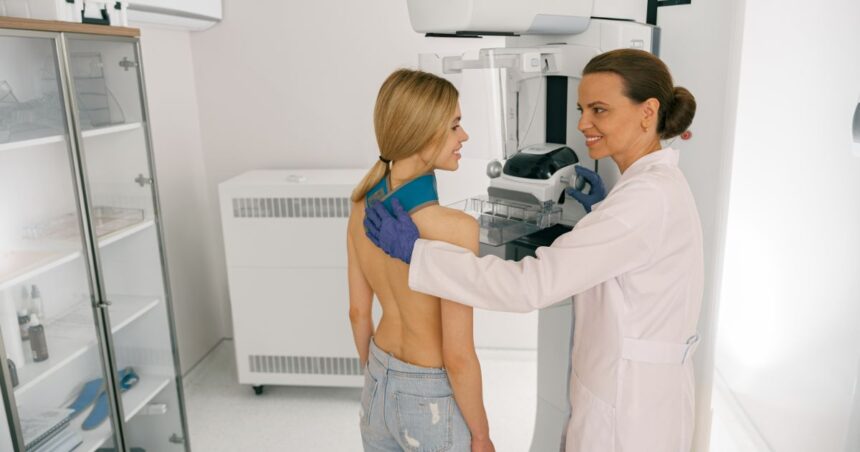Breast cancer screening has evolved significantly, and modern women now have two primary options for mammography: 2-D and 3-D imaging. Understanding the nuances between these approaches can empower you to make well-informed decisions about your breast health.
Conventional 2-D mammograms have long been the standard for early detection, capturing two-dimensional X-ray images of the breast. In contrast, 3-D mammography, or tomosynthesis, employs advanced technology to produce detailed, three-dimensional images. This enhanced visualization can offer improved cancer detection rates and reduced false positives compared to traditional 2-D scans.
Considering which screening method may be most suitable for your needs, it’s valuable to explore each approach’s unique benefits and practical considerations. Let’s discuss this comparison more deeply.
How 2-D Mammograms Work
2-D mammograms, or traditional mammograms, have been used for many years. In a 2-D mammogram, two X-ray images of each breast are taken from different angles. These images are then combined to create a flat, two-dimensional picture.
This method is effective for detecting abnormalities, such as lumps or masses, that could indicate breast cancer. Because the images are flat, seeing small details or detecting issues in dense breast tissue can sometimes be challenging.
How 3-D Mammograms Work
3-D mammograms, also known as tomosynthesis, are a newer technology. During a 3-D mammogram, multiple X-ray images are taken from different angles. These images are then combined to create a three-dimensional picture of the breast.
This combination allows doctors to see the breast tissue in much greater detail, layer by layer. Because of this, 3-D mammograms can often detect smaller abnormalities and provide a clearer picture, especially in women with dense breast tissue.
Benefits of 2-D Mammograms
2-D mammograms are widely available and have a long history of effectiveness in detecting breast cancer. They are usually quicker and less expensive than 3-D mammograms. For many women, a 2-D mammogram is sufficient for routine screening. Additionally, because they have been used for so long, a large amount of data and research supports their use. If you have had regular 2-D mammograms, your doctor can compare new images with your old ones to look for any changes.
Benefits of 3-D Mammograms
3-D mammograms offer several advantages over 2-D mammograms. The main benefit is that they provide a more detailed and accurate picture of the breast tissue. This can lead to earlier detection of breast cancer and fewer false positives, which occur when a mammogram suggests that there is a problem when there is none.
For women with dense breast tissue, 3-D mammograms are especially beneficial because they can see through the dense tissue more clearly. Although they are usually more expensive and take longer, many women find the extra detail and accuracy worthwhile.
What to Expect During a 2-D Mammogram
During a 2-D mammogram, you will be asked to stand before the X-ray machine. A technologist will position your breast on a flat surface and compress it with a paddle to spread the tissue. This compression is necessary for clear images and lasts only a few seconds.
You might feel some discomfort, but it should not be painful. The process is usually quick, taking about 20 minutes, and you can return to your normal activities immediately after.
What to Expect During a 3-D Mammogram
A 3-D mammogram is similar to a 2-D mammogram but takes longer because more images are taken. You stand in front of the X-ray machine, and your breast is positioned and compressed, just like in a 2-D mammogram.
The X-ray machine will move in an arc over your breast, taking multiple images from different angles. This process might take a few minutes longer than a 2-D mammogram, but it is still relatively quick and painless. After the images are taken, you can return to your regular activities.
Comparing the Accuracy
One of the most significant differences between 2-D and 3-D mammograms is their accuracy. Studies have shown that 3-D mammograms are more accurate in detecting breast cancer, especially in women with dense breast tissue. They are better at distinguishing between benign (non-cancerous) and malignant (cancerous) masses, which means fewer false positives.
However, 2-D mammograms are still very effective and are often used as the first step in breast cancer screening. Your doctor can help you decide which type of mammogram is best for you based on your risk factors and breast density.
Insurance and Cost Considerations
The cost of a mammogram can vary depending on whether it is a 2-D or 3-D mammogram. 2-D mammograms are generally less expensive and more likely to be fully covered by insurance.
3-D mammograms may have additional costs, and coverage can vary by insurance plan. It’s important to check with your insurance provider to understand what is covered and what your out-of-pocket costs might be. Some states require insurance companies to cover 3-D mammograms, so check the regulations in your area.
Conclusion
Understanding the main differences between 2-D and 3-D mammograms can help you make informed decisions about your breast health. Both types of mammograms have their benefits and are effective tools for detecting breast cancer.
2-D mammograms are widely available and cost-effective, while 3-D mammograms offer more detailed images and greater accuracy, especially for women with dense breast tissue. Discuss your options with your doctor to determine which type of mammogram is best for you.
With regular screening and early detection, you can take proactive steps to protect your health.

